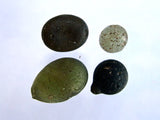February 02, 2014
Tasmanian Tektite - Darwin Glass

Darwin Glass is an impactite tektite 800 odd thousand years ago a large meteorite hit the west coast of Tasmania . Due to the heat and pressure waves generated as this meteorite hit the ground the base rocks of quartzite and slate were instantly melted and splashed out and solidified into a silica rich glass . Resulting in the famous darwin glass ,Tasmania's Moldavite . Found in colours ranging from white to black and various shades of green,including a beautiful transparent olive green.Darwin glass is unique in the world of impact tektites as part of its composition includes the original meteorite,both nickel and iron as well as chromium are included in it. Life has also recently been found in the vesicles of the glass by my friend Doctor Kieran Howard who has extensively studied the glass. The Rare and Beautiful has bought several old collections of glass collected in the 1960s and 70s before the area was included in the world heritage area and collecting was banned.We have also collected glass from areas outside of the park boundary .


In January 2014 our family decided to walk in to Darwin crater. Our 6 year old son is very interested in meteorites and wanted to see the impact crater from where it landed. A work colleague and friend from Tas Uni who helped map the crater in the 1970s drew us a map and off we went. The track in was very wet to say the least with many trees fallen across it. After an hour of bush bashing we gave up. Both our 3 and 6 year olds were over it , mud up to their knees heaps of blood sucking leeches and a few large tiger snakes convinced us to reluctantly head home. We didn't see any of the famous glass . A few weeks later we decided to give it another go, back into the mud we went and two hours later we made it to the end of the track. As the area is dense rainforest and the crater is full of sediment it was unfortunately unrecognisable, much to the disappointment of our two boys who were expecting a giant circular hole. We saw some small pieces of glass in the roots of an up turned tree but it certainly wasn't plentiful like we had read. We headed out to escape the Mosquitos and leeches and saw several large tiger snakes and a copper head on the track. The only creatures in this forest all wanted to bite us. As soon as we were out of the world heritage area we decided to search for some glass specimens, we climbed a likely looking hill and after an hour or so of fossicking around we found an easterly facing slope with some lovely glass specimens, some of a decent size and some lovely green pieces very much like moldavites.



The SW world heritage are of Tasmania where the crater is located is in dense rainforest ,surrounded by majestic mountains,an area that receives more than 3 meters of rain per year. For those that would like to know more about Darwin Glass Dr Kieren Howard has written some excellent papers on this magical impact tektite.






